Hakan Mehmetcik, Marmara University
Eric Lease Morgan, University of Notre Dame
Melih Kölük, Marmara University
Galip Yüksel, Istanbul University
Online social networking services (Facebook, Twitter, YouTube, etc.) have altered the way we engage with individuals, groups, and communities by profoundly changing our everyday information and communication habits on a global scale. Today, social media has also grown into a massive data repository providing very detailed information on the opinions, beliefs, and communications of millions of individuals. Similarly, social media analysis has grown into an essential method for various fields, including political science and international relations. The purpose of this study is to undertake a nuanced social media analysis using Twitter data to contextualize and assess the context, scope, and impact of Turkish IR scholars’ interactions on Twitter. Within the scope of the paper, network analysis, topic modeling, descriptive statistics, and regression analysis approaches will be employed to draw meaningful interpretations about their Twitter interactions. Our basic premise is that among Turkish IR scholars, there is a collective network that connects them in terms of interactions, attitudes, and opinions, and that network may be found by analyzing their Twitter data. This working assumption is not supported by the findings.
Online social networking services (SNSs) have revolutionized the way we engage with individuals, groups, and communities by altering our everyday information and communication habits. In its essence, social media differs from traditional media such as newspapers and television in terms of ease of use, accessibility, and ability to allow two-way or multidirectional interactions. Data flow based on user-generated multimedia content (images, videos, music, text), especially, is a very important feature.[i]SNSs have had a profound impact on society, communication, and various aspects of our lives. They have transformed the way we connect, share information, and engage with one another, ultimately shaping the dynamics of our interconnected world. In this sense, analyses based on social media data have the potential to explain very decisive trends, and this is true at the local, domestic, and international levels.[ii]
Social media analysis, in its most basic form, is the processing and analysis of social media data for a certain purpose and scope.[iii]In seeking to study this new information environment in a systemic way, social media analysis has developed an amalgam of approaches by integrating various methods and techniques available to different disciplines. Social media analysis has the potential to be extremely valuable today, particularly in the social sciences since it has also evolved into a vast data repository, providing extremely comprehensive information on a wide range of opinions, thoughts, and conversations. Parallel to these trends, scholars from various disciplines have come to exploit social media as a valuable source for their studies. When it comes to International Relations (IR), social media gets a lot of attention because of online disinformation campaigns and foreign election meddling, in particular. Yet, the number of academic projects and inquiries in the field is rapidly increasing.[iv]
This study is the result of the authors’ broader research interest in how Twitter[v]might be used to better understand various social phenomena that matter in political science and international relations. In this case, logic argues that Turkish scholars use Twitter, like many other professionals do, to convey information regarding their opinions, teaching, and research activities along with using it as a medium for academic exchanges with their peers. So, we can perform social media analysis by using Twitter data to contextualize and evaluate Turkish IR scholars’ social interactions and to determine whether these interactions reflect “an epistemic community” in terms of having a collective network among relations, opinions, and approaches.[vi]That is, our core assumptions are:
To make this inquiry, we employed three distinct and appropriate methods that are widely used in social media analytics:
SNSs allow users to share material in so many different formats such as text, music, and video. As such, they have evolved into massive data repositories. The data derived from these repositories provide very detailed insights into the perspectives, ideas, and activities of a diverse set of users. In this sense, these platforms present various possibilities for scientists interested in topics such as elections, language, political communication, conflict, etc.
Among the current popular SNSs, Twitter is an important one in terms of both data availability and scope.[vii] Since its inception in March 2006, it has swiftly evolved into a popular SNS, eventually becoming one of the largest SNSs with over 300 million accounts delivering 500 million messages every day. The data derived from Twitter is also rather straightforward to obtain, in contrast to many other similar SNSs. While other SNSs provide data access, none are as all-encompassing and practical as Twitter. Twitter’s worldwide reach, massive user base, and data transparency make it a perfect medium for large-scale social scientific inquiries. Thus, within the scope of this article, the analysis was carried out mainly using Twitter data.
We manually collected the Twitter accounts of Turkish IR scholars affiliated with Turkish universities through an extensive search process that involved examining the online presence of professors and scholars associated with IR departments. While we acknowledge that this approach may not capture every single Turkish IR scholar on Twitter, it enabled us to compile a comprehensive list of accounts belonging to Turkish IR scholars based at Turkish universities. It is important to note that our study specifically focuses on this particular group. We recognize the dynamic nature of Twitter, where new accounts are created, and existing ones may become inactive. Therefore, the exact number of accounts may vary over time. However, during data collection, we identified and included approximately 371 Turkish IR scholars with active Twitter handles. Thus, the compiled dataset contains about 536,000 tweets from 371 Turkish IR scholars ranging from 2009 to September 2021. Our data-collecting technique retrieves tweets from the list of profiles with an option for filtering the stream’s output by user account. In this case, the Twitter data comes in a semi-structured data frame, which makes it easier to work with the data. Given the fact that we are only interested in a relatively small group of accounts and their presence on Twitter, the volume of the compiled Twitter data is appropriate and representative (in our case, it is almost the whole population, if we define the population as Turkish IR scholars with a Twitter handle). The first two graphs in Figure 1 depicts the number of tweets per year and the most active ten users respectively.

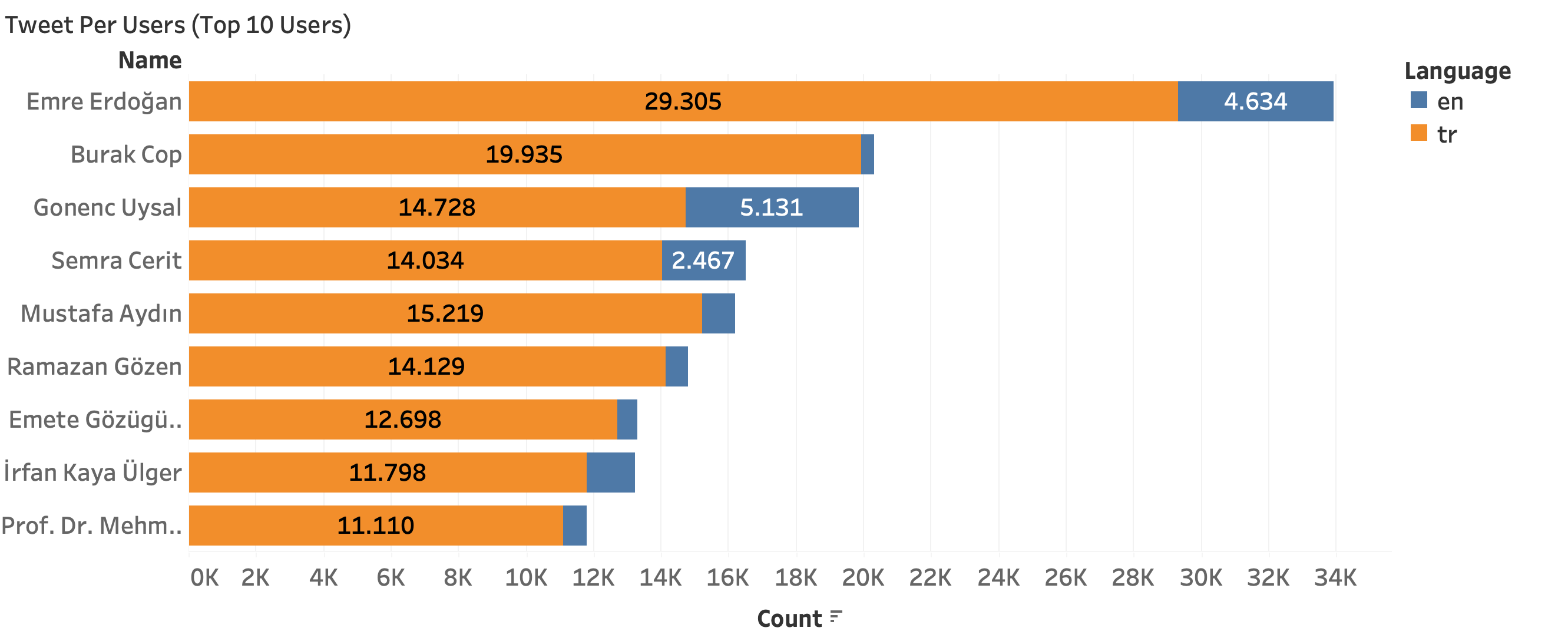

Figure 1: Tweets per year
The material was acquired in a range of languages, the bulk of which were Turkish and English (468,027 in Turkish and 68,594 in English, respectively). We removed any tweets in languages other than Turkish and English for the sake of data clarity and textual analysis readiness. The graph at the bottom of Figure 1 depicts the proportion of languages in the compiled data as well as part of the gender distribution of user accounts. It should be noted that, in addition to some other languages, we have excluded extreme outliers in terms of tweets (a user with more than 70,000 tweets and a few other users with fewer than 10 tweets in the last ten years) in order to limit a small number of highly active users from dominating the dataset. The decision to exclude users with fewer than 10 tweets in the last ten years was made with the intention of limiting the potential influence of inactive or sporadic users on our dataset. By setting a minimum threshold for tweet activity, we aimed to ensure that the included users have a reasonable level of engagement and contribution within the Twitter platform. In terms of both derived tweet and account numbers, the raw data statistic reveals a large skew towards male components, which is one of the factors we consider in making sense of the “followers” and “following” counts. The whole gender distribution spectrum is seen in in Figure 1 above. The figure gives the numbers of female and male profiles as percentages in the group, while it also provides the language of the tweets they posted.
The most important difficulty of working with big data is collecting and streamlining the data to make it suitable for use. There are similar difficulties in working with social media data as well. The process of extracting relevant, useful data from the massive amount of information posted on social media platforms requires researchers to use specially designed software to filter and analyze posts or machine learning systems that can directly perform such analysis. Within the scope of this study, the Python (data extraction, cleaning, and shaping) and R (data analysis and visualization) programming languages were used. In addition, we have used Gephi for network analysis. The topic modeling process was done with an external piece of software called Topic Modeling Tool. The whole working process is depicted in Figure 2 below.

Figure 2: Data Analysis Steps
Since the launch of Twitter in 2006, much new research examining various facets of Twitter data has emerged.[viii] Among such research are studies dealing with a wide range of themes, from opinion mining[ix] to event detection[x] and political discourse analysis.[xi] When it comes to scholars’ presence on social media, there are studies examining the prevalence of biases in scientific research across disciplines;[xii] dealing with web visibility as an important factor in measuring scientific productivity and impact;[xiii] measuring social influence through Social Network Analysis (SNA) metrics;[xiv] investigating the ways in which scholars use Twitter to cite and share scholarly information.[xv] Yet, there has been no study conducted on Turkish IR scholars’ presence on Twitter as a community.
Several distinct methods and approaches to Twitter data have also emerged in recent years. For instance, comparative and descriptive statistics derived from raw numbers of tweets per user, date, retweet, reply, and like counts are particularly insightful key metrics, and they are among the accepted standard for the quantitative description of user activities on Twitter. These metrics identify specific aspects of Twitter data, such as the most prolific users and node users within a given social network. Another way to look at Twitter content is to analyze the “tweet-text” itself. The textual social media data can also be analyzed using various advanced analytical methods and techniques, such as sentiment analysis, probabilistic/statistical topic modeling, natural language processing, machine learning, etc.
Some of these different methodologies/methods differ in their applicability and relevance.[xvi] The research question inquires whether there is a collective network among Turkish IR scholars that binds them in terms of interactions, opinions, perspectives, and views on a particular subject, and whether this can be read through their Twitter interactions. With this question in hand, we primarily used the following three methods:
Figure 1 above depicts a temporal trend suggesting that the quantity of tweets has risen dramatically in recent years. This is due, in part, to the fact that, despite its initial launch in March 2006, Twitter did not become a prominent platform until the 2010s. Most Turkish IR scholars’ accounts were also just activated in the mid-2010s. Therefore, we have very few entries in terms of tweets published before even 2012.

Figure 3: Year-on-year Tweet Count
The first descriptive statistic is the spatial-temporal analytics of activity.[xxii] In our case, this refers to the frequency of year-on-year tweet numbers and comparing these against the averages in order to detect the high- or low-frequency periods, which could indicate certain events or occurrences that are common to the whole group. Figure 3 above has been prepared for this reason. According to the figure, there is an exceptional increase in the number of tweets in the periods of 2013 July, 2016 July, and 2020 March-April, when the tweet count exceeds the average yearly tweet tally. The average number of tweets each year is 450 in 2009, 478 in 2010, 1,360 in 2011, 3,149 in 2012, 4,916 in 2013, 4,649 in 2014, 4,083 in 2015, 3,523 in 2016, 3,751 in 2017, 4,513 in 2018, 7,079 in 2019, and 7,180 in 2020. Only three occasions have overtaken the annual average in terms of tweet count. These dates correspond to concordance term analysis results; Egypt’s 2013 coup, the July 2016 attempted coup in Türkiye, and the initial Covid cases and subsequent lockdowns in March, April, and May of 2020, respectively. When we provide the topic modeling and network analysis results, we will return to these three suggestive occurrences in greater detail. However, it could be a good predictor that specific events provoked a collective reaction in our group. Even if this may not be the outcome of close connections between group members, we might still suggest that it is one of the markers pointing to ties binding Turkish IR scholars in terms of interactions, viewpoints, and perspectives on a particular topic. Twitter is well-known for its constantly shifting hot topics. These issues can be discussed as widely as current events. Yet, these are such events that we can suspect drive a high level of sharing, tweeting, and replying among the general Twitter audience. That is, these events are not unique to this group of Twitter users, and that is why we can suggest that analysis of the spatial-temporal analytics of activity does not reveal any type of network indications for Turkish IR scholars. Since 2009, there has not been even a single event that uniquely drives a within-group conversation among them.
The second type of descriptive statistic for the Twitter data are the indicators deriving from hashtags (#) and mentions (@). In Twitter jargon, hashtags are commonly utilized when discussing a topic or term. When speaking to or about someone, however, mentions are utilized (the user account of a person, brand, group, etc.). Both hashtags and mentions are very specific features for creating a network of intra-user interactions indicating common themes and viewpoints across issues and peoples.
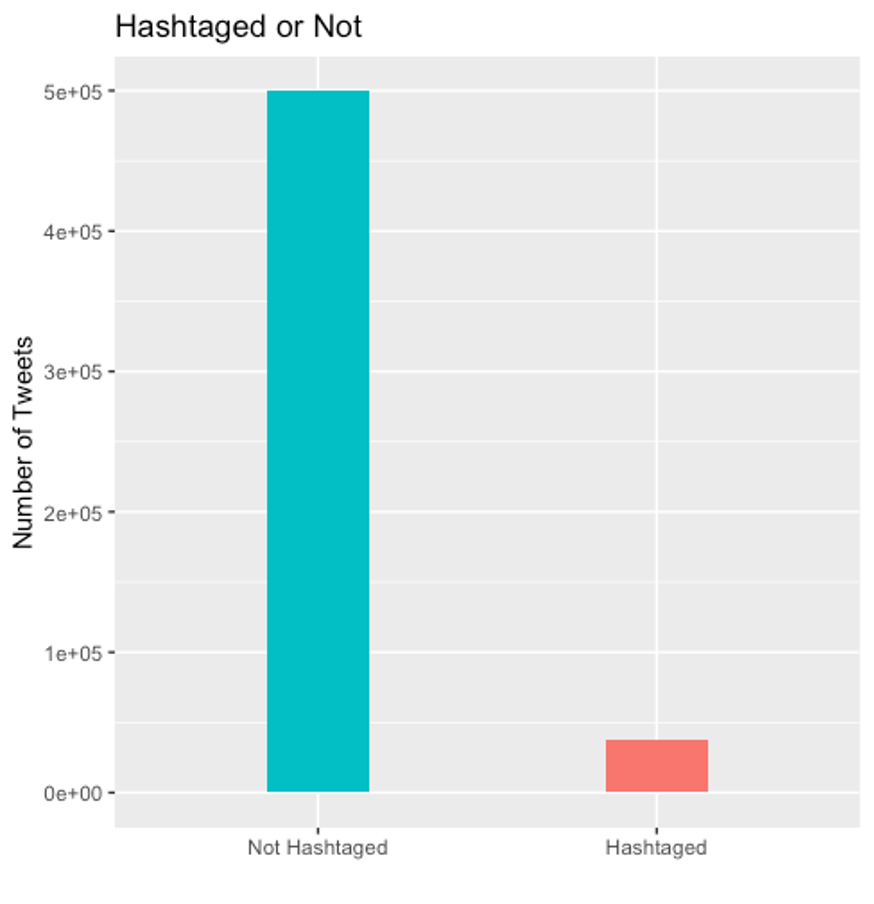
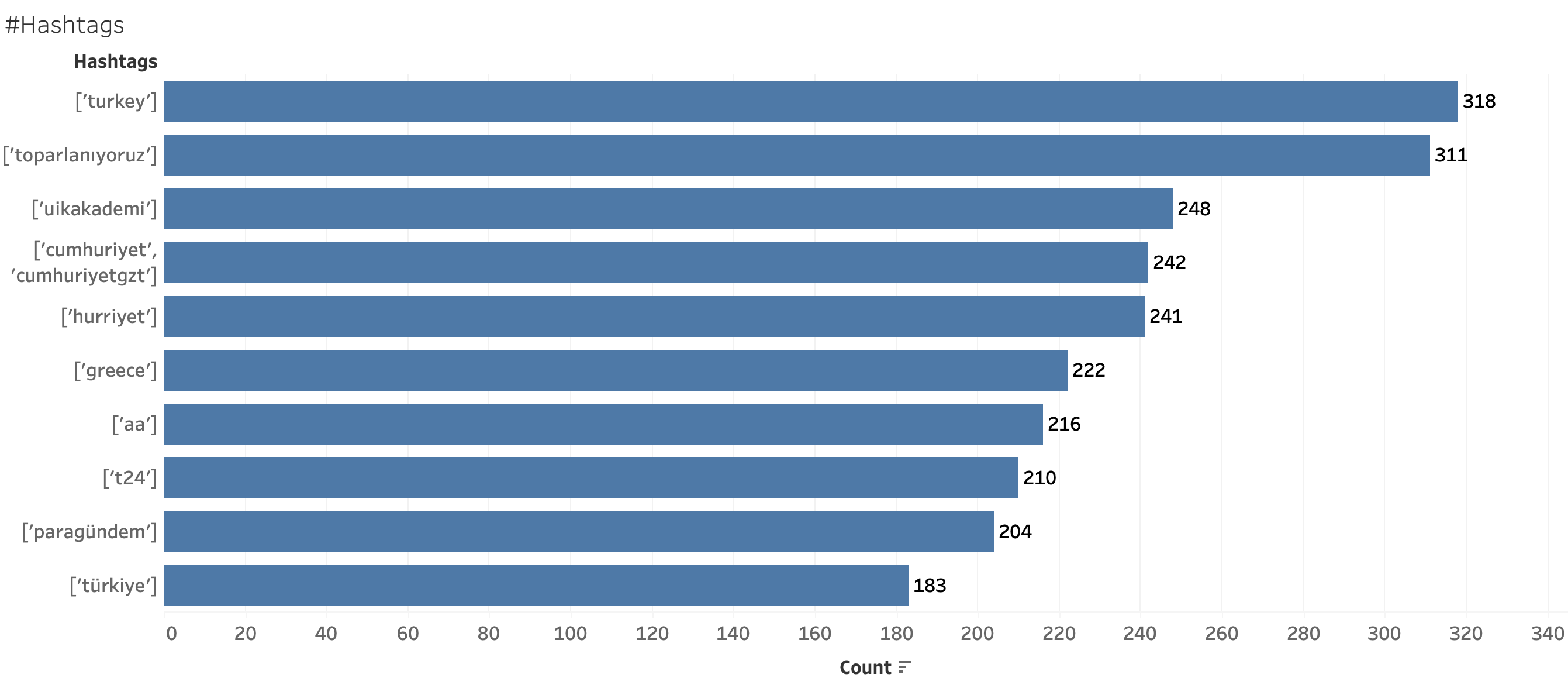
Figure 4: Hashtags
Figure 4 above and Figure 5 below show the ratio of hashtag or mentioned tweets in the whole sample of 536,621 Twitter posts. From the figures, we can easily see that these features are not fully operational, suggesting that there are few common themes among the group members. Figure 4 above and Figure 5 below also list the most common hashtags and mentions. We will make use of hashtags and mentions for the network analysis as well. Yet, for the generic interpretation, we can suggest that there emerge very few common themes in both hashtags and mentions such as uikakademi, Türkiye, Greece, Egypt, etc. Most of the hashtags and mentions involve news outlets, which also suggests that our group members generally share news, but do not create individual and original content and conversations on Twitter. It is also interesting that the three events derived from the spatial-temporal analytics of activity (Egypt’s 2013 coup, Türkiye’s attempted coup in July 2016, and the initial Covid cases and subsequent lockdowns in March, April, and May of 2020) are not among the top hashtags in the lists. These trends or hot topics either did not remain “hot” for long, or did not create enough discussion among the group. The limited engagement and conversation surrounding these hashtags indicates that they do not generate substantial individual and original content (or attention) among Turkish IR scholars. This observation aligns with our overall finding that there are few common themes connecting Turkish IR scholars in our dataset. This insight provides valuable context for understanding the engagement of Turkish IR scholars with these otherwise widely discussed topics.
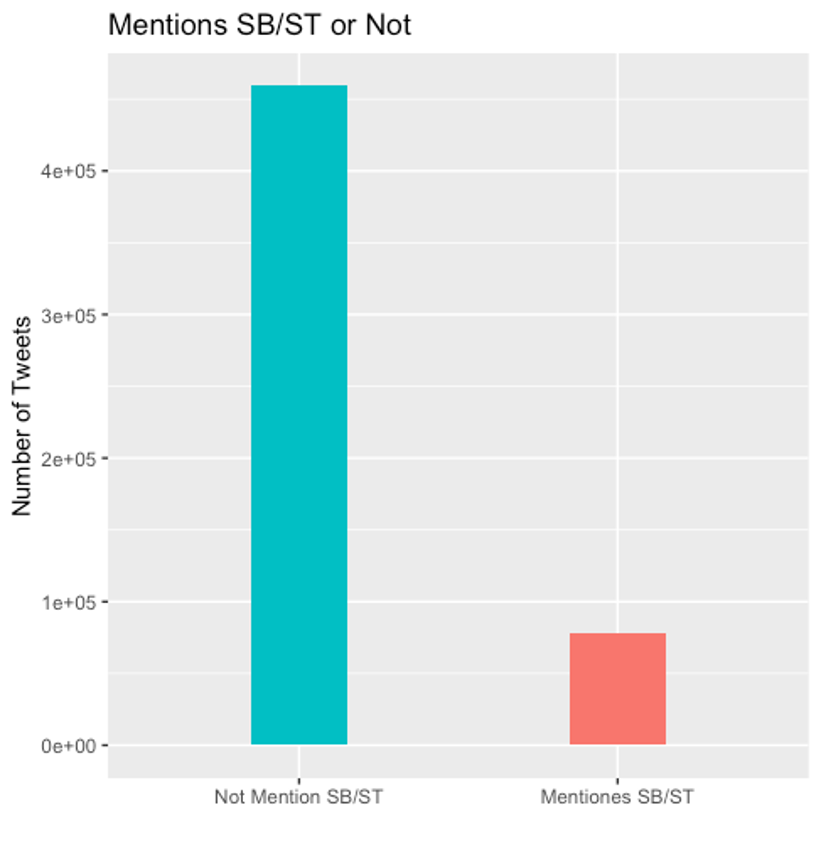
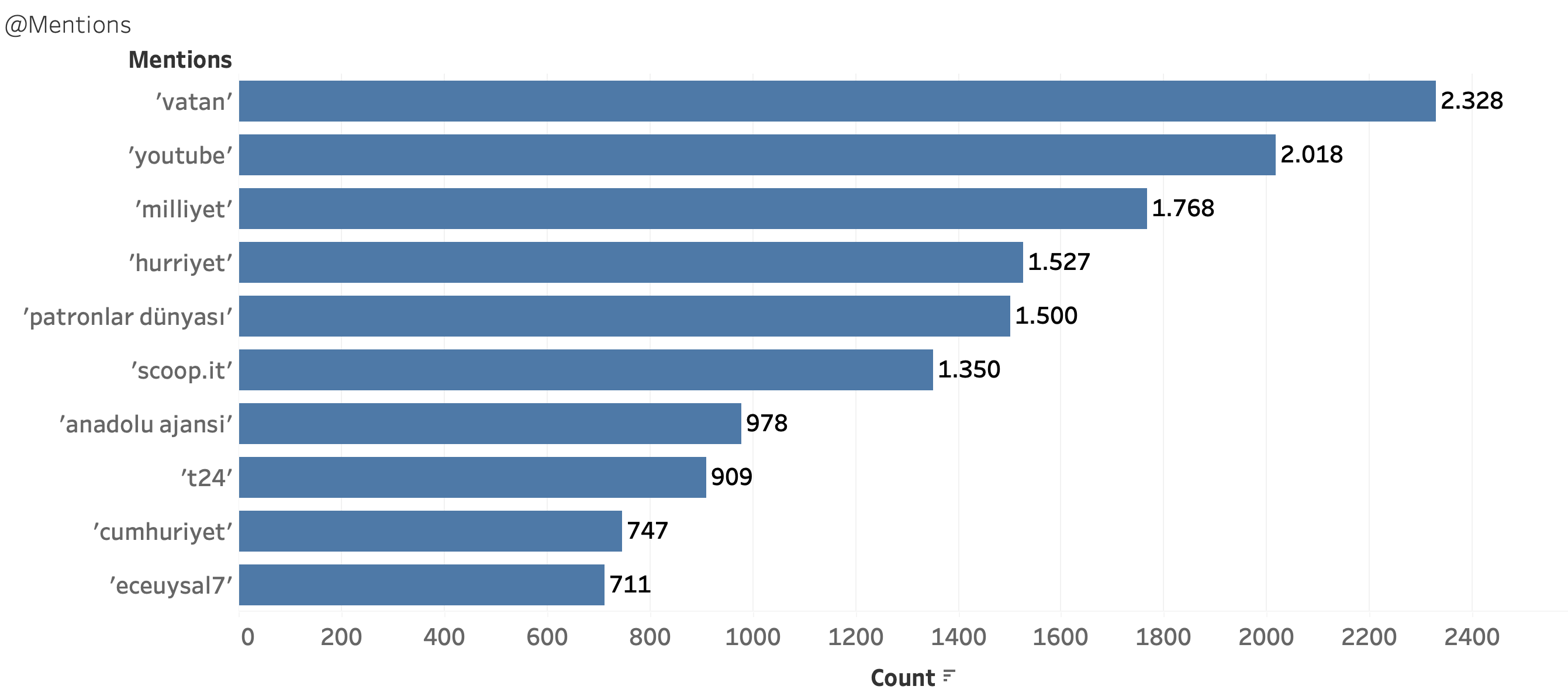
Figure 5: Mentions
Probably the most important metrics about the conversations happening on Twitter are the retweet, reply, and like counts.[xxiii] These metrics mean different things. A reply is technically a response to another tweet and is seen as an indicator of communication. That is, replies are responses to someone’s Twitter post, posted separately for a specific purpose. A retweet is just a shared duplicate of the same tweet, while a like suggests a person likes or agrees with the original post. Overall, replies are a step above retweets, and retweets are a step above likes in the Twitter-verse.[xxiv] These are important metrics because they are significant indicators of communication happening on Twitter. When we look at the reply, retweet, and like counts, we see the results shown in Figure 6 below. The figure suggests that many tweets are neither replied to, nor retweeted. When we compare averages, we see similar patterns revealing that very few tweets actually passed the average reply, like, or retweet counts.
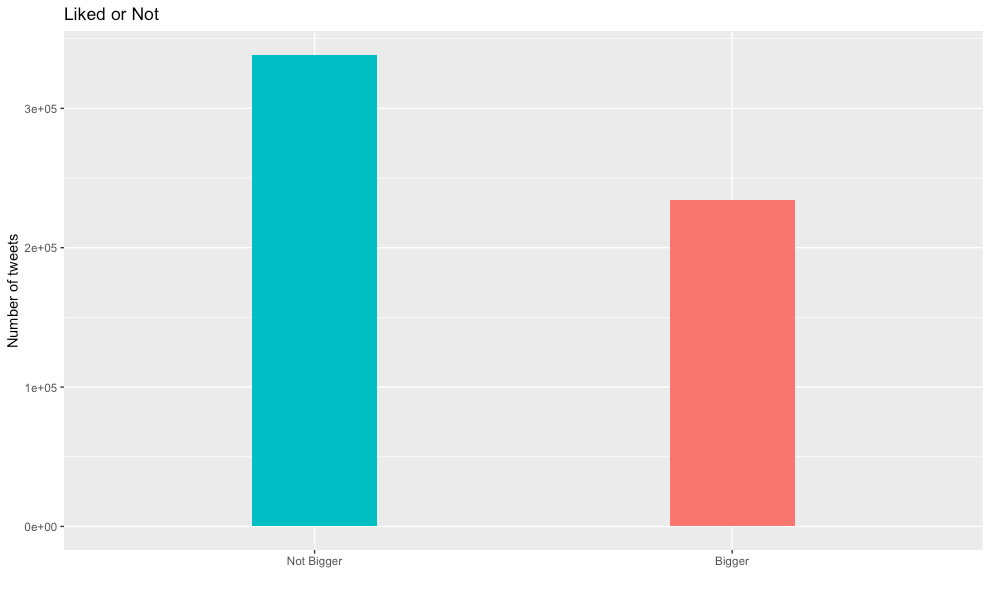
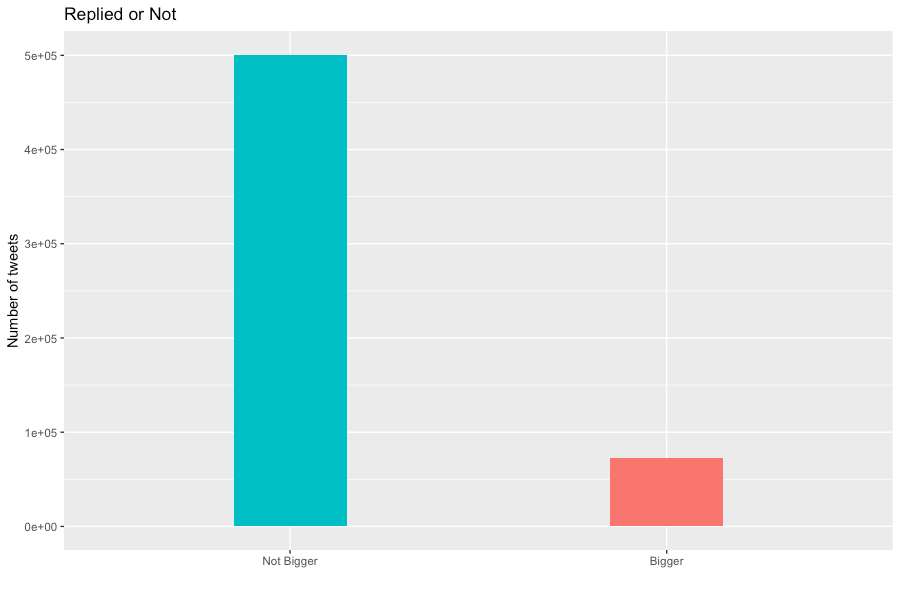
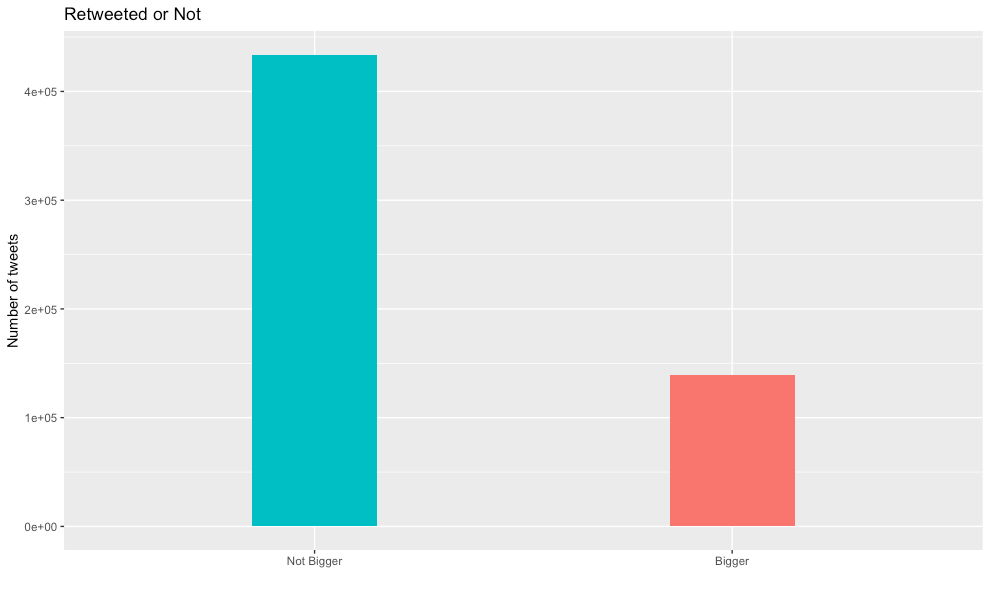
Figure 6: Retweets, Likes, and Replies
The actions of tweeting and retweeting indicate differences in terms of approach. For example, if a user only retweets, it alludes to a disseminative approach, while original tweeting indicates an annunciative approach[xxv], and replies denote a conversational approach.[xxvi] Hence, very few tweets are massively retweeted, liked, or replied to, which may be an important metric in terms of measuring the influence or the effect created on Twitter. These are also known as Engagement Metrics, which includes the number of retweets, likes, and replies a user’s tweets receive. Figure 6 clearly indicates that most of the tweets did not create any type of follow-up conversation. One of the takeaways from this is that the majority of Turkish IR scholars employ an annunciative approach that proclaims or affirms a certain stance or idea, which is not shared or approved.
Another way to look at these metrics is to find correlations. Follower count is only one such metric in quantifying social media influence per user. Retweet, like, and response counts can also be analyzed for this purpose. In general, these metrics are used to evaluate how viral specific tweets are. However, from the raw numbers, they indicate a wider influence. From the figure below, we may suggest that there is a positive correlation between follower count and these metrics. From the raw data, we can suggest a positive correlation (correlation does not necessarily mean causation) between likes and retweets for the selected sample of user metrics.
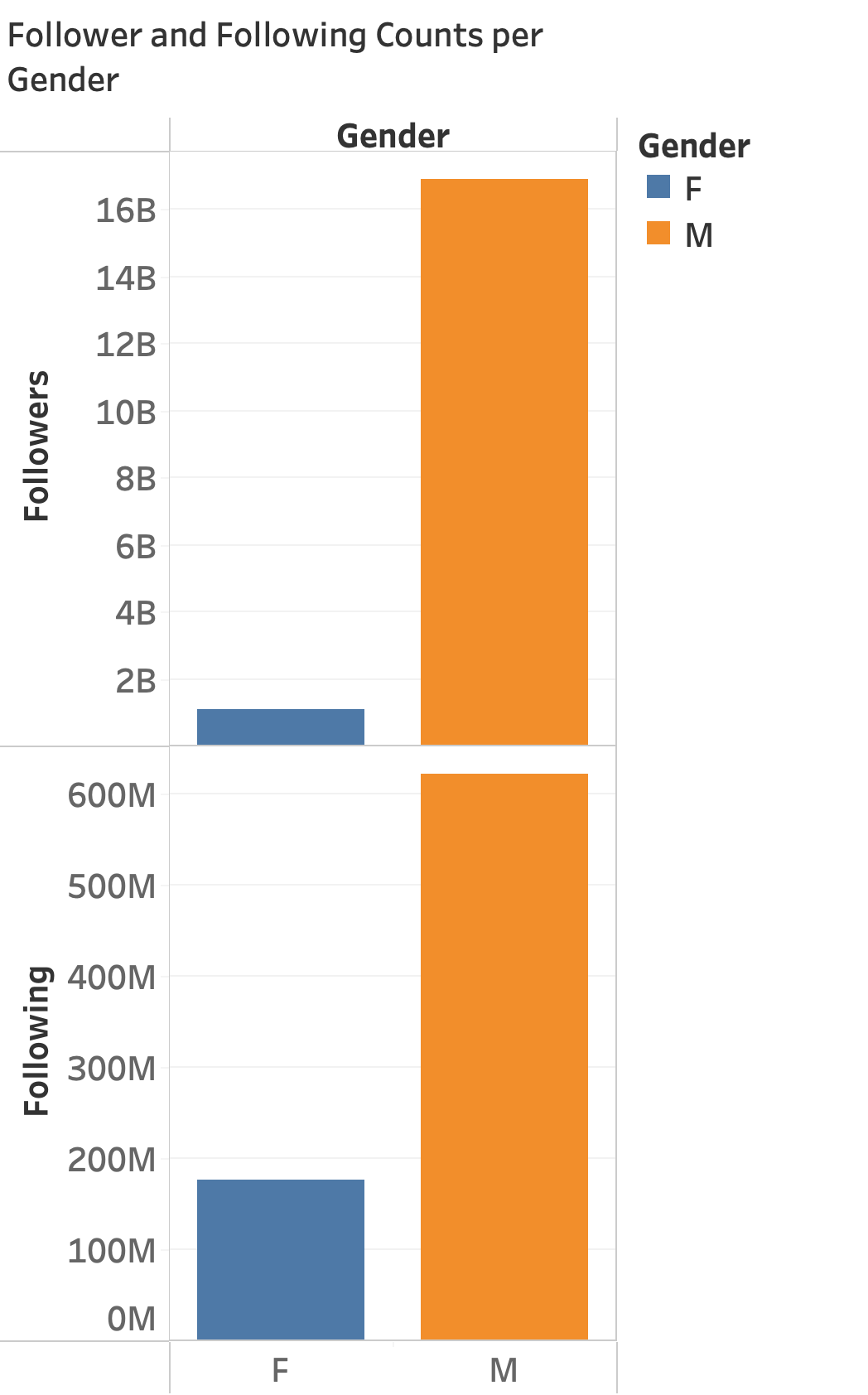
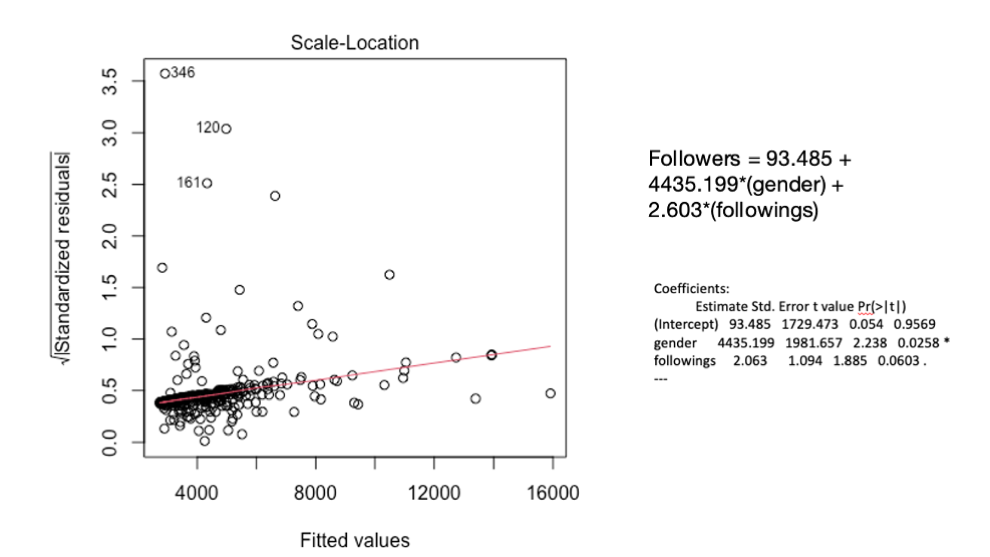 Figure 7: Follower count and gender distribution
Figure 7: Follower count and gender distribution
This type of correlation is common, yet it does not say much about the data itself. However, if we use this correlation in a different context, it would be much more insightful in terms of understanding the data. One way to do so is with a gender-based analysis. Figure 7 above shows the gender distribution of the data and how these followers and following metrics are distributed for males and females. From the figure, we can assume that there is a relationship between gender and follower and following counts. That is, being female or male statistically affects the number of people a user follows and is followed by. To check this, we ran a regression analysis by creating a dummy variable on gender. Our result, as reported in Figure 7, suggests that gender (being a male) seems to be statistically significant in terms of affecting follower and following counts. Concisely, gender emerges as a determinant influencing the magnitude and breadth of an individual’s social network on this platform. Although the gender factor might initially appear peripheral, it indeed offers substantial insights into the network of Turkish IR scholars on Twitter. It facilitates not only the identification of network participants but also the understanding of their interconnections and interactions. Primarily, the data suggests that males, having larger networks, could potentially occupy a more central role within the network, thereby influencing the dissemination of information and ideas among Turkish IR scholars. Equally, it is important to consider that if there is a noticeable lack of interaction within the network, a significant portion of the responsibility could potentially be attributed to the interaction patterns among males. This underscores the necessity for a more nuanced understanding of gender dynamics within social networks. This observation also further prompts an inquiry into the differential usage of Twitter by males and females, necessitating additional studies to explore the distinct communication and collaboration patterns across genders.
Users on Twitter are not just posting, consuming, and sharing material, but they are also forming networks. This behavior prompted us to study the users’ structural position via network analysis centrality metrics. In this section, we look at the Twitter follower/following network to see if there is a dense microstructure between Turkish IR scholars. It is worth repeating that our working hypothesis posits a community/network among Turkish IR scholars.
To begin with, one of the most frequent uptakes for network researchers is the “substructures” that might exist in a given network. The division of individuals into subgroups and substructures can be a crucial feature of social networks. From this pure and simple network perspective, we can suggest that there are several substructures in the studied group of users. Figure 8 in the appendix shows both followers’ networks on Twitter as a whole and followers’ networks among groups. When we compare these two maps, the first interesting finding that stands out is that there is a significant increase in the edge/node ratio. This indicates the strength of the network of relationships among the group. Again, when we look at the shape of the networks, the general follower map shows a more dispersed appearance as the links’ strength decreases compared to the second map. In the map we made for indicating an intragroup follower network, on the other hand, as the links’ strength increased, the nodes pulled each other more towards the center, and a relatively round shape emerged. This indicates that the rate of users within the group following each other is much higher than on the general map. That is, there is a tendency for Turkish IR scholars to follow each other. This is an important indication of a network among Turkish IR scholars. When we look at the purple segment, which is the largest segment of the map, we see that the active people are generally male professors working at private universities and female scholars working at state universities. This network finding requires further elaboration, yet it is an interesting indicator in itself.
Figure 9 in the online appendix shows gender-based follower network maps. On the left-hand side of the figure, we have the female follower map. One of the notable points on this map is that Emete Gözügüzelli and Aşkın İnci Sökmen Alaca are located at the periphery of the map, although their eigenvector centralities are not low. This shows that although these users have a large number of followers, these followers are not among Turkish IR scholars but are from the general Twitter population. On this map, the blue and purple segments appear in the center of the map. This means that the in-map relationship network of the group in this segment is stronger. When we look at the users in these two segments, we see Sinem Açıkmeşe, Sinem Ünaldigi Kocamaz, Emel Parlar Dal, Gonca Oğuz Gök, and Helin Sarı Ertem. These five female scholars are located together in the blue segment of the map that we created for the intragroup network, and this segment is in the center of that map. That is, the blue and purple segments on the female follower map represent a group of female IR scholars who have a strong in-map relationship network, meaning they follow and interact with each other more frequently. Therefore, the our earlier suggestion that males and females Turkish IR scholars might have different ways of interacting on Twitter is supported by this finding.
Figure 9, we have a male follower network map. When we look at this map, we see completely different names from the active people in the map we made for the intragroup follower network above. This shows that others do not follow the 25 most followed male IR scholars in the group, but their followers are originally from the general Twitter population. One of the striking points on this map is that the three scholars who make up the purple segment work in Ankara, two of them at the same university, and they can be clustered in the same circle. This is another indication about several interesting sub-subgroups (subgroup of a subgroup, sub-sub is not a typo).
When we look at the mentions, replies, and hashtags maps, we clearly see that the same subgroups are visible here as well. The colorings and distributions are quite similar to those presented in the lower side of Figure 10 above. This indicates that the subgroups in our network are also verified by the mentions, replies, and hashtags, which is reported in Figure 10 in the online appendix.
This part consists of a preliminary analysis of all tweet data and examines the themes (“topics”) contained in the dataset. In our study, we acknowledge the challenge of bilingual research and the unavailability of readily prepared dictionaries for topic modeling. As such, we created our own dictionaries by grouping relevant keywords[xxvii] together based on our research objectives and the context of Turkish IR scholars on Twitter. The topic modeling is divided into seven parts. Each part is outlined below. In each case, the topic modeling process denoted seven topics, 2,400 iterations, and a random number of views equal to 42. Because these values were constant throughout the analysis, the results ought to be considered preliminary; more thorough analysis would require different input values for different subsets of the data. It is worth reminding that our initial assumption is that there is a network among Turkish IR scholars. So, there should be common topics/themes in their conversations on Twitter. These identified topics may only consist of keywords, but they serve as a representation of the main subjects that are commonly discussed or mentioned by the scholars in our dataset. Therefore, the primary question we have in doing a text analysis is if these users talk about the same topics. It is important to note that the objective of our study was to identify and explore shared themes or subjects of discussion among Turkish IR scholars on Twitter.
Tweets were first extracted from the data based on year, as well as language. The general topics of the tweets written in Turkish and in English, and how they manifested over the last decade, are illustrated in Figure 11 in the online appendix (Turkish is on the upper part of the figure, while English is on the lower part):
From the figure, it can be seen that the topics (or issues) are similar in Turkish and English tweets. Türkiye and the coronavirus pandemic are prominent topics, yet Turkish-American relations and related topics also dominate the tweets posted by Turkish IR scholars. A similar result is reported when we look for the seven most frequent tweeters in both Turkish as well as English. Figure 12 in the online appendix depicts these topics. The most important result from the figure is that the most frequent tweeters do not tweet about the same things. It is as if they are carrying on a conversation with themselves without any tangible interactions with the rest of the group. This is a very important finding as it suggests a weak network between these Turkish IR scholars in terms of topics and issues. This goes against the general assumption that Turkish IR academics have a dense network and that there is a lot of communication and collaboration between them. This is important because it means that Turkish IR scholars are not constantly learning from each other and sharing ideas.
The comparison of tweets by each gender is interesting. In both of the languages, females tended to tweet on a more diverse set of topics when compared to males. Figure 13 in the online appendix shows this finding.
In Figure 14 in the online appendix shows tweets written by users with an above-average number of followers are examined for both Turkish- and English-written tweets.
In Figure 15 b in the online appendix shows, tweets written by users with an above-average following count are examined for both Turkish- and English-written tweets.
Both figures (Figure 14 for users with an above-average follower count, and Figure 15 for users with an above-average following count) show that the topics are incredibly varied, and that the users don’t talk about the same things.
Overall, the dataset represents a variety of subjects, but one, “Türkiye,” and the issues that characterize Turkish-American relations clearly stand out. Interestingly, there is very little or no reference to the more sophisticated issues. For example, there are expected topics with regard to cultural aspects of foreign policy, such as Türkiye, Turkish, Turks, etc. However, there are other Turkish foreign policy subjects, and most of them even appear in hashtags such as #lethistorydecide, #operationfriedensquelle, #operationpeacespring, etc. One such foreign policy slogan, “Enterprising and Humanitarian Foreign Policy,”[xxviii] was mentioned very few times. As is known from the related literature, Türkiye is happy to make its humanitarian and development aid efforts a niche diplomacy field by presenting itself as a humanitarian/virtuous state.[xxix] Turkish NGOs run humanitarian aid campaigns that result in public diplomacy outcomes, and these actions help Türkiye’s soft power in recipient countries while also bolstering the country’s attempts to be known as a ‘humanitarian power.’[xxx] Given this, it is surprising to see very few mentions of this aspect of foreign policy. This is just an example; we can extend this type of argument to many other issues as well. For example, another interesting aspect lacking here is the mention of “Global IR,” or any other theoretical nuances. Such findings suggest that Turkish IR scholars did not attempt to establish dialogue on Twitter about the topics of International Relations, but they use the platform in terms of an annunciative approach rather than a conversational approach.
Conversation analysts investigate how individuals negotiate the meaning of the conversation in which they are engaged and the wider discourse of which the conversation is a part. The tweets of Turkish IR scholars were expected to constitute a corpus of academic discourse rather than a corpus of causal dialogue. However, the initial analyses suggest otherwise. In order to extract additional but more subtle themes, further analysis would necessitate raising the number of desirable subjects from seven to any other number. Tweets published in Turkish and tweets written in English are comparable in general. The most active tweeters, on the other hand, do not all tweet about the same topics. It is almost as though they are talking to themselves. This finding also confirms the earlier suggestion about an annunciative approach. The gender contrast of tweets is intriguing. The difference in tweet content based on gender is quite interesting. Compared to males, females tend to tweet about a wider variety of topics in both languages. This observation seems to support the earlier finding of differences in communication styles among males and females. The number of likes and retweets a tweet receives seems to be influenced by the overall themes of the tweets. Moreover, the tweets written by users who tweet frequently seem to be reflected in the tweets of their followers and those they follow.
Online social networking services (Facebook, Twitter, YouTube, and others) have revolutionized the way we engage with individuals, organizations, and communities during the last decade, and have radically altered our daily information and communication habits on a worldwide scale. People utilize social media platforms to communicate knowledge and influence others all around the world nowadays. As a result, social media analysis, which has evolved into a massive data repository that gives highly comprehensive information on a wide variety of relevant users’ viewpoints, ideas, and communications, has become an important method in International Relations as well.
In this paper, the analysis was conducted using Twitter data. We prepared a collection of Turkish IR scholars’ tweets. Between 2009 and 2021, the data collection comprises around 536,000 tweets from 371 Turkish IR researchers. This study examined Turkish IR scholars’ Twitter interactions in order to make sense of their socialization. The primary research question was whether their social interactions represent “an epistemic community” in terms of a common network of links, attitudes, and methods. We used three separate and relevant methodologies to conduct a scientific investigation: descriptive statistics and regression analyses, network analysis, and textual analytics and topic modeling. This sophisticated approach was especially employed in this study to identify if this group of users addressed similar themes or issues in their Twitter posts. That is, we asked if they were talking about the same subjects, and if so, what are key issues that link this group together? This study also demonstrates methodological eclecticism by employing a large number of independent variables and a substantial amount of qualitative and quantitative data on these variables, as discussed above in terms of datasets and data analysis approaches.
Overall, our findings indicate that based on the raw tweet counts, we can suggest that specific events provoked a collective reaction in our group. In our sample, 2013 July (corresponding with the coup in Egypt), the 2016 coup attempt in Türkiye, and the 2020 Covid pandemic are events attracting more social networking among the selected group of users. However, this does not indicate any close networks among the group, since these issues are not unique to the group. The spatial-temporal analytics of activity does not reveal such events.
Meanwhile, the findings suggest that the majority of Turkish IR scholars use an annunciative style, in which they announce or confirm a given attitude or notion that is not accepted or endorsed by others. Few tweets are retweeted, liked, or replied to in large numbers, indicating that tweeting has minimal communication value for the selected group. Most importantly, the most active tweeters and the most liked, replied, and retweeted tweets do not all focus on the same things. It is almost as though they are conversing with themselves. Unsurprisingly, the data shows that there is only a handful of commonly shared themes emerging in both hashtags and mentions. “Türkiye” and the “challenges that defined Turkish-American relations” seem to be among the few common topics that stand out. Otherwise, and surprisingly, there is little or no mention of the more complicated topics.
It is also possible to reach some conclusions about trends in follower counts and trends, as well as the existence of various subgroups from a network perspective. The network analysis shows that the rate of group members following each other is substantially greater than the general map. That is, Turkish IR scholars have a propensity to follow each other. The top 25 male IR academics, on the other hand, are not followed by others in the group, and their followers are generally pulled from the broader Twitter population. According to the statistics, gender (being a man) also appears to have a statistically significant impact on the follower and following counts. Meanwhile, all the subgroups in our network are also validated by the mentions, responses, and hashtags network maps.
To conclude, we can suspect from their Twitter interactions that the discipline of IR in Türkiye is not well-connected, and that there is a very low level of communication and collaboration between Turkish IR scholars. We should mention that the level of communication and collaboration pertains to the observed interactions on Twitter, and scholars may engage in communication and collaboration through other means, such as traditional academic channels, conferences, and research collaborations. Our study was designed to explore the dynamics of their interactions within the realm of social media. Yet, there are some studies showing similar results with citation and collaboration patterns among Turkish IR scholars.[xxxi] Nonetheless, the finding that the discipline of IR in Türkiye at academician levels is not well-connected is interesting. It suggests that there may be some challenges to communication and collaboration between scholars in this field. There are a few possible explanations for this finding. One possibility is that the discipline of IR is relatively new in Türkiye, and that there is still a lack of established networks and channels for communication between scholars. Another possibility is that there are cultural or institutional factors that make it difficult for scholars to collaborate. For example, there may be a lack of funding for collaborative research projects, or there may be a preference for individual research over collaborative research. Whatever the reasons, the finding that the discipline of IR in Türkiye is not well-connected has some implications. First, it suggests that scholars in this field may be missing out on opportunities to learn from each other and to share ideas. Second, it suggests that the discipline may be less likely to evolve and adapt to new challenges. Overall, the finding suggests that the discipline of IR in Türkiye may be less influential than it could be. If scholars are not communicating and collaborating with each other, they are less likely to be able to make their voices heard and have an impact on policy and practice.
Notes
[i] Ioannis Pitas, Graph-Based Social Media Analysis, vol. 39 (CRC Press, 2016).
[ii] Alex Georgakopoulou, Stefan Iversen, and Carsten Stage, Quantified Storytelling (Springer, 2020), 7.
[iii] Luke Sloan and Anabel Quan-Haase, The SAGE Handbook of Social Media Research Methods (Sage, 2017).
[iv] Sarah Kreps, Social Media and International Relations (Cambridge University Press, 2020); Ravi Gupta and Hugh Brooks, Using Social Media for Global Security (John Wiley & Sons, 2013); thedigitalage, “The Role of Social Media in International Relations,” The Digital Age (blog), October 4, 2017, https://blogs.unsw.edu.au/thedigitalage/blog/2017/10/the-role-of-social-media-in-international-relations/.
[v] This article was written prior to the changes implemented by Elon Musk on the platform formerly known as Twitter. Please note that in the current context, 'tweets' are now referred to as 'posts' and 'retweets' are now 'reposts' on the platform now known as 'X'. The terminology in this article reflects the state of affairs at the time of data collection, wrangling and manuscript writing.
[vi] An “epistemic community” is a network of specialists with accepted competence and authoritative claims to policy-relevant knowledge in a certain subject area. These experts may come from a variety of backgrounds, but they all share a set of opinions on the most important challenges in their field.
[vii] Oshini Goonetilleke et al., “Twitter Analytics: A Big Data Management Perspective,” ACM SIGKDD Explorations Newsletter 16, no. 1 (September 25, 2014): 11–20, https://doi.org/10.1145/2674026.2674029.
[viii] Goonetilleke et al., “Twitter Analytics.”
[ix] Amandeep Kaur and Vishal Gupta, “A Survey on Sentiment Analysis and Opinion Mining Techniques,” Journal of Emerging Technologies in Web Intelligence 5, no. 4 (2013): 367–71; Bing Liu, “Sentiment Analysis and Opinion Mining,” Synthesis Lectures on Human Language Technologies 5, no. 1 (2012): 1–167; Alexander Pak and Patrick Paroubek, “Twitter as a Corpus for Sentiment Analysis and Opinion Mining.,” in LREc, vol. 10, 2010, 1320–26.
[x] Hamed Abdelhaq, Christian Sengstock, and Michael Gertz, “Eventweet: Online Localized Event Detection from Twitter,” Proceedings of the VLDB Endowment 6, no. 12 (2013): 1326–29; Farzindar Atefeh and Wael Khreich, “A Survey of Techniques for Event Detection in Twitter,” Computational Intelligence 31, no. 1 (2015): 132–64.
[xi] Kristen Johnson and Dan Goldwasser, “Identifying Stance by Analyzing Political Discourse on Twitter,” in Proceedings of the First Workshop on NLP and Computational Social Science, 2016, 66–75; Mohd Faizal Kasmani, “A Political Discourse Analysis of the Twitter Posts Of@ Najibrazak Prior to 2018 General Elections,” SEARCH (Malaysia) 11, no. 2 (2019): 129–43.
[xii] Daniele Fanelli, Rodrigo Costas, and John PA Ioannidis, “Meta-Assessment of Bias in Science,” Proceedings of the National Academy of Sciences 114, no. 14 (2017): 3714–19.
[xiii] Chung Joo Chung and Han Woo Park, “Web Visibility of Scholars in Media and Communication Journals,” Scientometrics 93, no. 1 (October 1, 2012): 207–15, https://doi.org/10.1007/s11192-012-0707-8; Judit Bar-Ilan et al., “Beyond Citations: Scholars’ Visibility on the Social Web” (arXiv, May 25, 2012), http://arxiv.org/abs/1205.5611.
[xiv] Hirotoshi Takeda, Duane Truex, and Michael Cuellar, “Evaluating Scholarly Influence Through Social Network Analysis: The Next Step in Evaluating Scholarly Influence,” (2010). AMCIS 2010 Proceedings. 573. https://aisel.aisnet.org/amcis2010/573.
[xv] Jason Priem and Kaitlin Light Costello, “How and Why Scholars Cite on Twitter,” Proceedings of the American Society for Information Science and Technology 47, no. 1 (2010): 1–4, https://doi.org/10.1002/meet.14504701201.
[xvi] Gupta and Brooks, Using Social Media for Global Security, 329.
[xvii] Bongwon Suh et al., “Want to Be Retweeted? Large Scale Analytics on Factors Impacting Retweet in Twitter Network,” in 2010 IEEE Second International Conference on Social Computing (2010 IEEE Second International Conference on Social Computing (SocialCom), Minneapolis, MN, USA: IEEE, 2010), 177–84, https://doi.org/10.1109/SocialCom.2010.33.
[xviii] Mi Kyung Lee et al., “Mapping a Twitter Scholarly Communication Network: A Case of the Association of Internet Researchers’ Conference,” Scientometrics 112 (2017): 767–97; Zhao Jianqiang, Gui Xiaolin, and Tian Feng, “A New Method of Identifying Influential Users in the Micro-Blog Networks,” IEEE Access 5 (2017): 3008–15.
[xix] Xia Hu and Huan Liu, “Text Analytics in Social Media,” in Mining Text Data (Springer, 2012), 385–414.
[xx] Axel Bruns and Stefan Stieglitz, “Metrics for Understanding Communication on Twitter,” ed. Katrin Weller et al., 2014, 69–82.
[xxi] Kentaro Sasaki, Tomohiro Yoshikawa, and Takeshi Furuhashi, “Twitter-TTM: An Efficient Online Topic Modeling for Twitter Considering Dynamics of User Interests and Topic Trends,” in 2014 Joint 7th International Conference on Soft Computing and Intelligent Systems (SCIS) and 15th International Symposium on Advanced Intelligent Systems (ISIS) (IEEE, 2014), 440–45; Ximing Li et al., “Filtering out the Noise in Short Text Topic Modeling,” Information Sciences 456 (2018): 83–96.
[xxii] Hakan Mehmetci̇k, Melih Koluk, and Galip Yüksel, “Perceptions of Türkiye in the US Congress: A Twitter Data Analysis,” Uluslararası İlişkiler Dergisi Vol. 19, No. 76, 2022, pp. 69–89, DOI: 10.33458/uidergisi.1226450
[xxiii] “Quote tweets” (originally “retweet with comment”) were not included in the data collection process.
[xxiv] We know this from a leaked source code from Twitter. See Ryan Mac and Kate Conger, “Twitter Says Parts of Its Source Code Were Leaked Online,” The New York Times, March 26, 2023, sec. Technology, https://www.nytimes.com/2023/03/26/technology/twitter-source-code-leak.html.
[xxv] The annunciative approach in social media refers to a user behavior where the user primarily posts original content, also known as native tweets. This is in contrast to a disseminative approach, where a user primarily shares others’ content, such as retweets. In essence, an annunciative approach is more about creating and sharing one’s own content, it may or may not be shared by the others while a disseminative approach is more about spreading existing content.
[xxvi] Bruns and Stieglitz, “Metrics for Understanding Communication on Twitter”; H. Mehmetcik and E. Salihi, “To Be or Not To Be: Twitter Presence among Turkish Diplomats,” Vestnik MGIMO-Universiteta 15, no. 3 (2022): 175–201, https://doi.org/10.24833/2071-8160-2022-3-84-175-201.
[xxvii] In this study, relevant keywords for topic modeling include terms related to international relations, political science, or specific subfields within IR that Turkish scholars commonly use in their tweets, such as “international relations,” “foreign policy,” “security studies,” or “diplomacy.” Additionally, terms associated with common themes in international relations, like “conflict,” “cooperation,” “human rights,” “global governance,” or “national sovereignty,” were considered in the development of our keyword dictionaries.
[xxviii] See Republic of Türkiye Ministry of Foreign Affairs. “Türkiye’s Enterprising and Humanitarian Foreign Policy,” (Last Accessed: July 31, 2021). URL: https://www.mfa.gov.tr/synopsis-of-the-turkish-foreign-policy.en.mfa.
[xxix] “Virtuous Power New Defense Doctrine: Turkish President,” Hürriyet Daily News, June 4, 2012, http://www.hurriyetdailynews.com/virtuous-power-new-defense-doctrine-turkish-president.aspx?pageID=238&nID=17784&NewsCatID=338.
[xxx] Hakan Mehmetcik, “Humanitarian NGOs: Motivations, Challenges and Contributions to Turkish Foreign Policy,” PERCEPTIONS: Journal of International Affairs 24, no. 2 (2019): 249–78.
[xxxi] Hakan Mehmetcik and Hakan Hakses, “Turkish IR Journals through a Bibliometric Lens,” All Azimuth: A Journal of Foreign Policy and Peace 12, no. 1 (2023): 61-84; Hakan Mehmetcik, Emel Parlar Dal, and Hasan Hakses, “Studying Turkish Foreign Policy: Whither A Community of Research?,” Alternatives: Turkish Journal of International Relations under review (2023).
Bibliography
Abdelhaq, Hamed, Christian Sengstock, and Michael Gertz. “Eventweet: Online Localized Event Detection from Twitter.” Proceedings of the VLDB Endowment 6, no. 12 (2013): 1326–29.
Atefeh, Farzindar, and Wael Khreich. “A Survey of Techniques for Event Detection in Twitter.” Computational Intelligence 31, no. 1 (2015): 132–64.
Bar-Ilan, Judit, Stefanie Haustein, Isabella Peters, Jason Priem, Hadas Shema, and Jens Terliesner. “Beyond Citations: Scholars’ Visibility on the Social Web.” arXiv, May 25, 2012. http://arxiv.org/abs/1205.5611.
Bruns, Axel, and Stefan Stieglitz. “Metrics for Understanding Communication on Twitter.” edited by Katrin Weller, Axel Burns, Jean Burgess, Merja Mahrt, and Cornelius Puschmann, 69–82, 2014.
Chung, Chung Joo, and Han Woo Park. “Web Visibility of Scholars in Media and Communication Journals.” Scientometrics 93, no. 1 (October 1, 2012): 207–15. https://doi.org/10.1007/s11192-012-0707-8.
Fanelli, Daniele, Rodrigo Costas, and John PA Ioannidis. “Meta-Assessment of Bias in Science.” Proceedings of the National Academy of Sciences 114, no. 14 (2017): 3714–19.
Georgakopoulou, Alex, Stefan Iversen, and Carsten Stage. Quantified Storytelling. Springer, 2020.
Goonetilleke, Oshini, Timos Sellis, Xiuzhen Zhang, and Saket Sathe. “Twitter Analytics: A Big Data Management Perspective.” ACM SIGKDD Explorations Newsletter 16, no. 1 (September 25, 2014): 11–20. https://doi.org/10.1145/2674026.2674029.
Gupta, Ravi, and Hugh Brooks. Using Social Media for Global Security. John Wiley & Sons, 2013.
Hu, Xia, and Huan Liu. “Text Analytics in Social Media.” In Mining Text Data, 385–414. Springer, 2012.
Hürriyet Daily News. “Virtuous Power New Defense Doctrine: Turkish President,” June 4, 2012. http://www.hurriyetdailynews.com/virtuous-power-new-defense-doctrine-turkish-president.aspx?pageID=238&nID=17784&NewsCatID=338.
Jianqiang, Zhao, Gui Xiaolin, and Tian Feng. “A New Method of Identifying Influential Users in the Micro-Blog Networks.” IEEE Access 5 (2017): 3008–15.
Johnson, Kristen, and Dan Goldwasser. “Identifying Stance by Analyzing Political Discourse on Twitter.” In Proceedings of the First Workshop on NLP and Computational Social Science, 66–75, 2016.
Kasmani, Mohd Faizal. “A Political Discourse Analysis of the Twitter Posts Of@ Najibrazak Prior to 2018 General Elections.” SEARCH (Malaysia) 11, no. 2 (2019): 129–43.
Kaur, Amandeep, and Vishal Gupta. “A Survey on Sentiment Analysis and Opinion Mining Techniques.” Journal of Emerging Technologies in Web Intelligence 5, no. 4 (2013): 367–71.
Kreps, Sarah. Social Media and International Relations. Cambridge University Press, 2020.
Lee, Mi Kyung, Ho Young Yoon, Marc Smith, Hye Jin Park, and Han Woo Park. “Mapping a Twitter Scholarly Communication Network: A Case of the Association of Internet Researchers’ Conference.” Scientometrics 112 (2017): 767–97.
Li, Ximing, Yue Wang, Ang Zhang, Changchun Li, Jinjin Chi, and Jihong Ouyang. “Filtering out the Noise in Short Text Topic Modeling.” Information Sciences 456 (2018): 83–96.
Liu, Bing. “Sentiment Analysis and Opinion Mining.” Synthesis Lectures on Human Language Technologies 5, no. 1 (2012): 1–167.
Mac, Ryan, and Kate Conger. “Twitter Says Parts of Its Source Code Were Leaked Online.” The New York Times, March 26, 2023, sec. Technology. https://www.nytimes.com/2023/03/26/technology/twitter-source-code-leak.html.
Mehmetcik, H., and E. Salihi. “To Be or Not To Be: Twitter Presence among Turkish Diplomats.” Vestnik MGIMO-Universiteta 15, no. 3 (2022): 175–201. https://doi.org/10.24833/2071-8160-2022-3-84-175-201.
Mehmetcik, Hakan. “Humanitarian NGOs: Motivations, Challenges and Contributions to Turkish Foreign Policy.” PERCEPTIONS: Journal of International Affairs 24, no. 2 (2019): 249–78.
Mehmetcik, Hakan, Emel Parlar Dal, and Hasan Hakses. “Studying Turkish Foreign Policy: Whither A Community of Research?” Alternatives: Turkish Journal of International Relations under review (2023).
Mehmetcik, Hakan, and Hakan Hakses. “Turkish IR Journals through a Bibliometric Lens.” All Azimuth: A Journal of Foreign Policy and Peace 12, no. 1 (2023): 61–84.
Mehmetci̇k, Hakan, Melih Koluk, and Galip Yuksel. “Perceptions of Türkiye in the US Congress: A Twitter Data Analysis.” Uluslararası İlişkiler Dergisi Vol. 19, No. 76, 2022, pp. 69–89. DOI: 10.33458/uidergisi.1226450
Pak, Alexander, and Patrick Paroubek. “Twitter as a Corpus for Sentiment Analysis and Opinion Mining.” In LREc, 10:1320–26, 2010.
Pitas, Ioannis. Graph-Based Social Media Analysis. Vol. 39. CRC Press, 2016.
Priem, Jason, and Kaitlin Light Costello. “How and Why Scholars Cite on Twitter.” Proceedings of the American Society for Information Science and Technology 47, no. 1 (2010): 1–4. https://doi.org/10.1002/meet.14504701201.
Republic of Türkiye Ministry of Foreign Affairs. “Türkiye’s Enterprising and Humanitarian Foreign Policy.” Accessed July 31, 2021. https://www.mfa.gov.tr/synopsis-of-the-turkish-foreign-policy.en.mfa.
Sasaki, Kentaro, Tomohiro Yoshikawa, and Takeshi Furuhashi. “Twitter-TTM: An Efficient Online Topic Modeling for Twitter Considering Dynamics of User Interests and Topic Trends.” In 2014 Joint 7th International Conference on Soft Computing and Intelligent Systems (SCIS) and 15th International Symposium on Advanced Intelligent Systems (ISIS), 440–45. IEEE, 2014.
Sloan, Luke, and Anabel Quan-Haase. The SAGE Handbook of Social Media Research Methods. Sage, 2017.
Suh, Bongwon, Lichan Hong, Peter Pirolli, and Ed H. Chi. “Want to Be Retweeted? Large Scale Analytics on Factors Impacting Retweet in Twitter Network.” In 2010 IEEE Second International Conference on Social Computing, 177–84. Minneapolis, MN, USA: IEEE, 2010. https://doi.org/10.1109/SocialCom.2010.33.
Takeda, Hirotoshi, Duane Truex, and Michael Cuellar. “Evaluating Scholarly Influence Through Social Network Analysis: The Next Step in Evaluating Scholarly Influence.” Presented at the AMCIS 2010 Proceedings, August 1, 2010. https://aisel.aisnet.org/amcis2010/573.
thedigitalage. “The Role of Social Media in International Relations.” The Digital Age (blog), October 4, 2017. https://blogs.unsw.edu.au/thedigitalage/blog/2017/10/the-role-of-social-media-in-international-relations/.

